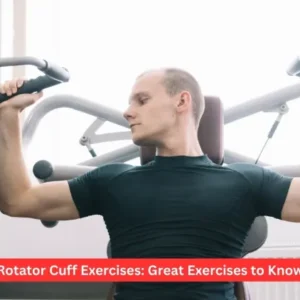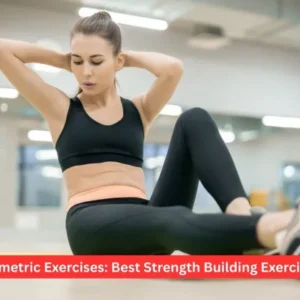Among the best exercises to use to develop the upper torso is the barbell row. This workout will pull several back, shoulder, arm, and core muscles into one big pull. Due to the work with a free barbell, the force has to be stabilised by yourself to strengthen the core and the postural muscles. It builds size, strength, as well as balance, coordination, and athleticism compared to machines.
In contrast to isolation movements, the barbell row balances and trains your ability to produce a hinge along the hips as a deadlift would, and a stationary spine. It is a powerful pattern on which other lifts, like pull-ups, cleans, and even presses, are based. What you get is a more powerful, leaner and healthier body, complete with a back that looks and works better.
- Why the Barbell Row Matters
- Lateral Rotator Muscles Worked by the Barbell Row
- The Barbell Row- How to do it correctly
- Key Form Tips
- Common Mistakes to Avoid
- These are versions of the Barbell Row
- Programming the Barbell Row
- Bonus biceps Options to the Barbell Row
- Fat Loss and the Barbell Row
- The Secrets of Sculpting a Bigger and Wider Back.
- Rows, Shoulders, and Arms
- Barbell Rows vs. Other Rowing Movements
- The Secret To Rowing on a Barbell Lift
- Rest, Improvement, and Development
- Conclusion
- Frequently Asked Questions
Why the Barbell Row Matters
No healthy back program would be incomplete without any form of the barbell row. Pulling is done horizontally, where you have the vertical pulling on the pull-ups or lat pulldowns. This is achieved by giving thickness to the mid-back; the balance also enhances posture, opposing rounded shoulders that may arise as a result of sitting or from too much bench pressing.
Key benefits include:
- Complete development of upper back- Engages lats, rhomboids, traps and rear delts together.
- Increased pulling strength – A heavier barbell row is a sure boost to deadlifts, pull-ups, and Olympic lifts.
- Core and spinal stability- Having the bent-over position strengthens the lower back, abs, and obliques.
- Ability to do everything- Beginners can begin with lighter weights, or dumbbells; experienced lifters can go on with heavier weights to build mass.
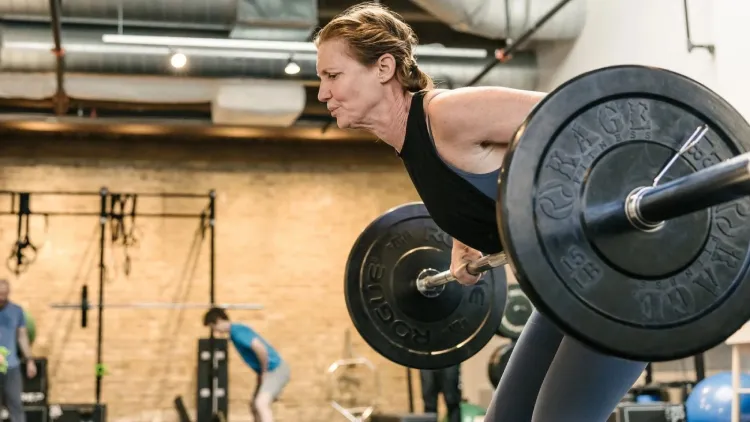
Lateral Rotator Muscles Worked by the Barbell Row
The barbell row makes almost all the muscles of the back chain work:
- Latissimus Dorsi (Lats): Adults Leading muscles, which draw the arms in the direction of the single body and form a V-shaped appearance.
- Rhomboids and Middle Trapezius: Need to grab the shoulder blades and pull them toward one another in order to have the right reaction and thickness.
- Rear Delts: Strengthen the support of the shoulders and provide rounding of the shoulder back.
- Erector Spinae: Run parallel in the spine and maintain the neutral under load, developing lower-endurance in the back.
- Biceps and Forearms: help in drawing the bar and enhance the strength of grips.
- Glutes and Hamstrings: Stabilise the hip hinge position when rowing heavily.
Regular barbell rows develop a thick, dense mid-back, lats spread wide and strong arms, all of which are synonymous with athletic upper body overtime.
The Barbell Row- How to do it correctly
Set Up:
- Put a loaded barbell on the ground.
- Your feet should be approximately shoulder-width apart, and the bar should be taken slightly greater than the width of your shoulders.
- Take an overhand (pronated) grip to engage the upper-back more or an underhand (supinated) grip to work the lower lats and biceps.
Body Position:
- Flex your knees a little and bend your hips forward until you have a complete 45-degree torso-floor angle (others use almost a right angle).
- Maintain a straight back, raised chest and stiffen your core.
The Row:
- Draw the bar backwards to your upper abdomen or lower chest.
- Pull your shoulders together at the top and give a little rest.
- Raising, slowly and in complete control, to the starting point.
Breathing:
- Inhale as you lower the bar.
- Breathe out and pull the bar towards you.
- It is a method of safeguarding your lower back and, at the same time, making the target muscles do the work.
Key Form Tips
- Neutral Spine: It is important that you do not round your back at the lower part and instead maintain it straight and firm.
- Controlled Speed: It is necessary to make the movement continuous and not spurring or rocking the weight.
- Grip Understanding: Begin at shoulder width. A broader grip strikes a greater portion of the upper back, and a slimmer grip concentrates upon the lats.
- No Leaning Back Nicolently: The torso angle should remain the same: erect, straight through the lift to have the right musculature into action.

Common Mistakes to Avoid
- Bending the Back: This is excessively stressful to the spine and may be injurious.
- Too Much Weight: Trade-off of “forms to load only nullifies the benefits and makes people more prone to injury.
- Standing Too Upright: This moves look like more of a shrug than a row.
- Failure to retire Scapular Retraction: This is the inability to squeeze the shoulder blades to activate the back.
- Going Too Fast: A slow, or measured tempo, elevates time under tension and muscle recruitment.
These are versions of the Barbell Row
- Pendlay Row: This is a movement that begins on the floor and is focused on powerful explosions and a perfect structure.
- Underhand (Supinated) Row: Intensifies the working of the lower lats and the biceps.
- Yates Row: is slightly more erect with an underhand grip in terms of thickness.
- Smith Machine Row: Provides a set track path to the bar to provide additional safety during the initial introduction to the motion.
- Dumbbell Rows: Dumbbell rows are a perfect exercise for first-time users or for fixing muscle asymmetry between sides.
The variations have a slightly different angle of pull so that you can work on your back development.
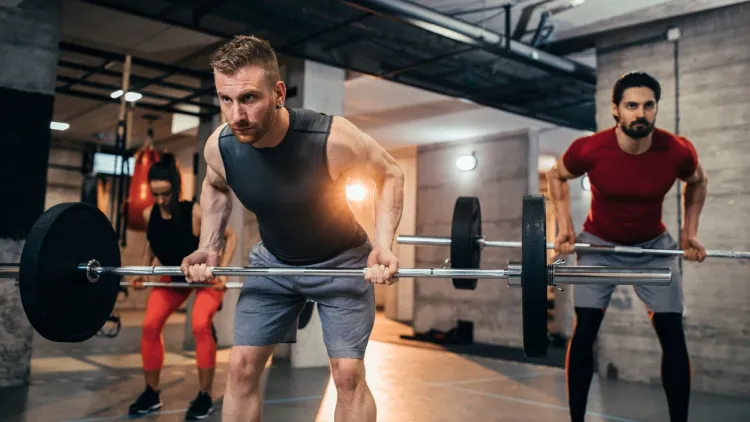
Programming the Barbell Row
- Novices: 3 rounds of 8 -10 runs with moderate weight.
- Intermediate/Advanced: 4-5 sets of 6-8 reps with progressive overload.
- Frequency: Once or twice per week is sufficient for the majority of lifters.
- Parendris: This should be matched with vertical pulls (pull-ups or pulldowns) and deadlifts to make up a full back workout.
The bulk of lifters require doing one or two good rowing drills in each session. Be quality-conscious rather than quantity-conscious and stack on endless sets.
Bonus biceps Options to the Barbell Row
- Grip: Overhand (Pronated): This grip is the best to use generally to get good back development, particularly the traps and rear delts.
- Underhand (Supinated) Grip: From these recommendations differs therefore transferring the tension is transferred more to the lower lats and biceps.
- Mixed or Neutral Grip: This type can be taken to alleviate grip fatigue, but is not as frequent.
The distance between your hands should not be less than shoulder width, although you are free to squeeze a bit further towards both directions to stress various muscles.
Fat Loss and the Barbell Row
Although the barbell row is a key strength and hypertrophy exercise, it does burn calories, and when used alongside a calorie-dictated diet, can aid in fat loss. It also burns more calories due to the fact that it utilises vast amounts of muscle mass and elevates your metabolism following training. Nonetheless, it will not be weight-fattening, but by far nutrition and general level of activity are the primary causes of fat burn.
The Secrets of Sculpting a Bigger and Wider Back.
This idea is created through the barbell row, which makes the torso thick and wide:
- Thickness: Grows out of the rhomboids, mid-traps and the spinal erectors, all are extensively utilised in the rows.
- Width: This is due to the lats, and the row will be working at a different angle compared to the pull-ups or pulldowns work.
To achieve the optimal outcomes, combine them with vertical pulling exercises and shrugs. There is a gradual expansion of your back, an increase in your V-taper, and reinforcement of your posture by this combination.
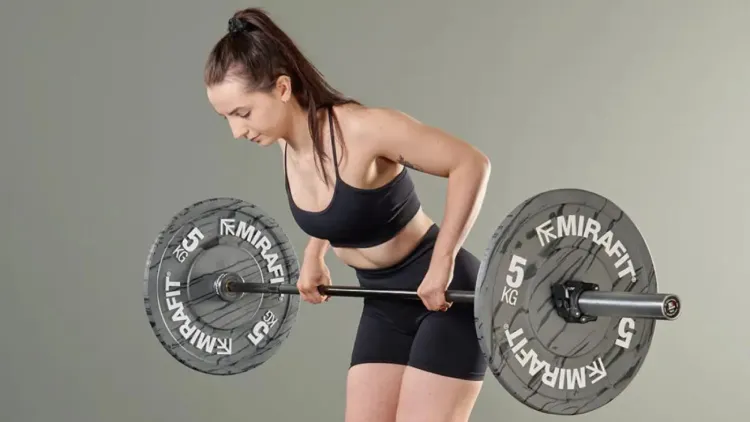
Rows, Shoulders, and Arms
The barbell row also indirectly appeals to stronger shoulders and arms because the secondary movers of the barbell row are the rear delts and biceps. Although you need not just do rows to grow arms or shoulders, you can count on them to grow your body on all sides, and to give support he pressing.
Barbell Rows vs. Other Rowing Movements
- Dumbbell Rows: Good with novices, or to remedy imbalances, but is not as loaded as the barbell row.
- T-Bar Rows: This will provide a prescribed arc of rotation in which the weight can be loaded, but may not offer as much core stability as barbell rows.
- Pull-Ups: This is very effective in width, but less effective in the thickness of the mid-back.
Generally, the barbell row is the most dynamic and versatile and the most fundamental horizontal pull.
The Secret To Rowing on a Barbell Lift
You are to feel the action mainly in your mid-back, lats and rear delts – not only in the lower back or arms. Following the session, you might feel slight back pain in the lats and traps, which indicates that you used the correct muscles. Video recording or having a coach can also be used to spot irregularities in form.
Rest, Improvement, and Development
- Warm your hamstrings, glutes, and core, then heavy rows.
- Raise weight slowly; do not hurry.
- Take a 4872-hour break between extreme back workouts so you get a complete rest.
- Grab hold. Use grab straps or chalk when needed.
Since the barbell row also targets the lower back, complement it with activities that complement spinal erectors and glutes, e.g. Romanian deadlifts or good mornings.

Conclusion
Barbell row has been known to be one of the most efficient exercises for strengthening the back, making it slower, thicker, and broader. It enhances pulling strength, posture and general athletics because it trains more than one muscle at a time. Be it creating muscle, gaining strength, improving sports performance or promoting fat loss, the barbell row is easily accessible to include in your program and would show visible improvements in the long run.
The barbell row can beat most rowing exercises when done properly; that is, taking notice of grip, proper torso position and controlled movement. It is a time-tested classic, and it works. Have it in your training regularly, develop slowly, and you will see your back changing.
Frequently Asked Questions
1. Which muscles is the barbell row the most effective for?
The main muscles which are targeted by the barbell row are the latissimus dorsi, rhomboids, middle traps, and rear delts, although the spinal erectors, glutes, hamstrings, biceps, and forearms are also involved. This causes it to be one of the best exercises to get a thicker and wider back.
2. What tells me whether I do barbell rows the right way?
The movement should be experienced in your mid-back, lats, and rear delts and not in your lower back or arms. The national spine is in a neutral position. Keep your torso in the same position, and pull the bar down in a controlled manner. Note-taking, your shape, or using a coach would also enable you to perfect your technique.
3. Are Barbell rows superior to dumbbell rows?
These two exercises are both excellent, but the barbell row should be favoured with heavier loads and more stabilising muscles; thus, it should be used in the development of overall strength and the build-up of thickness. Dumbbell rows are very good when one wants to balance between sides or when some contractions are needed.
4. Is fat loss possible with the barbell row?
Although it may not be the case that the barbell row causes fat burning directly, it makes one burn more calories by relying on a large group of muscles. Together with appropriate nutrition and a general workout regimen, it can aid with fat burning as well as muscle building.




